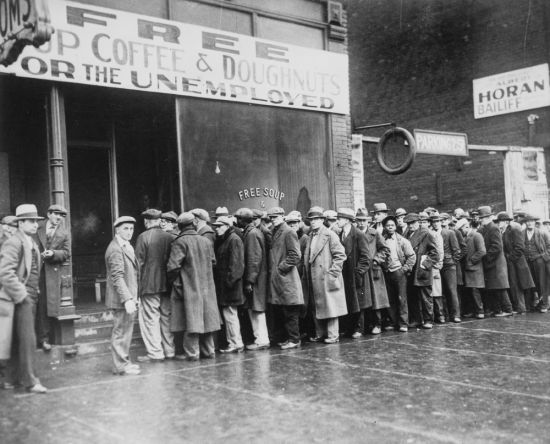The Memory of Great Depression
回憶大蕭條
The Great Depression was a severe worldwide economic depression in the decade preceding World War II. The timing of the Great Depression varied across nations, but in most countries it started in about 1929 and lasted until the late 1930s or early 1940s. It was the longest, most widespread, and deepest depression of the 20th century, and is used in the 21st century as an example of how far the world’s economy can decline. The depression originated in the United States, triggered by the stock market crash of October 29, 1929 (known as Black Tuesday), but quickly spread to almost every country in the world.
大蕭條是一場發生在二戰前10年嚴重的全球性經濟蕭條。大蕭條發生的時間在各國各不相同,但是在大多數國家都是從1929年開始持續到30年代末期或是40年代初期。這是20世紀持續時間最長、波及范圍最廣、影響最大的一次嚴重蕭條,而且這次蕭條也被21世紀的人們拿來當做經濟衰退的例子,告訴人們經濟可以衰退到什么程度。這場大蕭條始于美國,由1929年10月29日(也就是人們常說的黑色星期二)股市崩盤引發,然后迅速蔓延至全球許多國家。
The Great Depression had devastating effects in virtually every country, rich and poor. Personal income, tax revenue, profits and prices dropped, and international trade plunged by half to two-thirds. Unemployment in the United States rose to 25%, and in some countries rose as high as 33%. Cities all around the world were hit hard, especially those dependent on heavy industry. Construction was virtually halted in many countries. Farming and rural areas suffered as crop prices fell by approximately 60 percent. Facing plummeting demand with few alternate sources of jobs, areas dependent on primary sector industries such as cash cropping, mining and logging suffered the most.
這次大蕭條幾乎對每個國家都產生了毀滅性的影響,不管是富國還是窮國。個人收入、稅收、盈利和價格下降、國際貿易業減少了一半甚至三分之二。美國的失業率上升至25%,而在其他一些國家失業率甚至高達33%。全球許多城市都遭受到了重創,特別是那些依賴于重工業的地區。很多國家的建設都幾乎暫停。農業和郊區都遭遇了農產品價格下降近6成的損失。面對直線下降的需求和無法供應足夠的可替代工作崗位,第一產業部門遭受到的損失最為嚴重,例如經濟作物種植業、煤礦業和伐木業。

Historians most often attribute the start of the Great Depression to the sudden and total collapse of the US stock market on October 29th, 1929, known as Black Tuesday. However, some dispute this conclusion, and see the stock crash as a symptom,rather than a cause of the Great Depression. Even after the Wall Street Crash of 1929, optimism persisted for some time; John D. Rockefeller said that "These are days when many are discouraged. In the 93 years of my life, depressions have come and gone. Prosperity has always returned and will again." The stock market turned upward in early 1930, returning to early 1929 levels by April, though still almost 30% below the peak of September 1929. Together, government and business actually spent more in the first half of 1930 than in the corresponding period of the previous year. But consumers, many of whom had suffered severe losses in the stock market the previous year, cut back their expenditures by ten percent, and a severe drought ravaged the agricultural heartland of the USA beginning in the summer of 1930.
歷史學家經常把1929年10月29日(黑色星期二)美國股市的突然和全面崩盤作為此次大蕭條的開端。然而,對此結論有人看法不同,他們認為股市崩盤只是一個現象而不是造成大蕭條的原因。即使在1929年華爾街股市崩盤之后,樂觀主義者仍舊堅持了一段時間;約翰·洛克菲勒就說:“過在那段時間里,很多人都失去了信心。在我生命的93年里,蕭條總是來了又走。繁榮總是會再次回來。”股市在30年代早期開始回暖,在4月回升到1929年以前的水平,盡管比1929年9月最高峰時期仍低了近30%。政府和商業在30年代前五年的加起來的花費比大蕭條之前的幾年的花費更多。但是消費者其中很多在前些年的股市崩盤中遭受了嚴重的損失,他們不得不減少了近一成的開支費用,并且1930年夏天開始,一場嚴重的旱災襲擊了美國農業的核心地帶。
By mid-1930,interest rates had dropped to low levels, but expected deflation and the reluctance of people to add new debt by borrowing, meant that consumer spending and investment were depressed. In May 1930, automobile sales had declined to below the levels of 1928. Prices in general began to decline, but wages held steady in 1930; but then a deflationary spiral started in 1931. Conditions were worse in farming areas, where commodity prices plunged, and in mining and logging areas, where unemployment was high and there were few other jobs. The decline in the US economy was the factor that pulled down most other countries at first, then internal weaknesses or strengths in each country made conditions worse or better. Frantic attempts to shore up the economies of individual nations through protectionist policies, such as the 1930 US Smoot-Hawley Tariff Act and retaliatory tariffs in other countries, exacerbated the collapse in global trade. By late in 1930, a steady decline set in which reached bottom by March 1933.
到30年代中期,利率開始下降到較低水平,但是預期的通貨緊縮和人們不想通過借債增加新債的心理,意味著消費和投資將會下降。1930年5月,汽車銷量下降到比1928年更低的水平。1930年物價普遍下降,但是工資卻保持平穩;從1931年開始通貨緊縮程度開始螺旋式上升。農業地區的情況更為糟糕,他們的商品價格下降,而在煤礦和伐木領域,失業率非常高且幾乎沒有其他工作可做。一開始,美國經濟的衰退是導致其他國家經濟蕭條的重要原因之一,接著各國各自的優劣勢使得情況或好或壞。急切地想要發展經濟的想法使得很多國家實施保護主義政策,比如1930年的美國斯穆特一霍利關稅協議和其他國家報復性的關稅設定,加速了全球貿易的崩潰。到1930年末期,一場持續衰退一直到1933年的3月達到了谷底。












